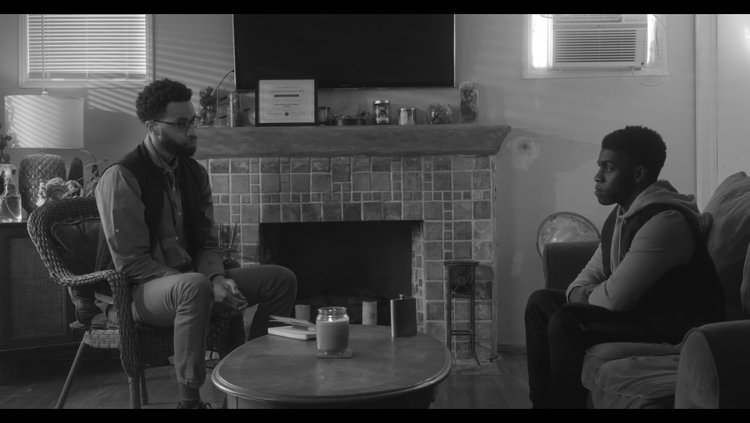‘Mickey Hardaway' (2023) Review: The Turbulence and Agony of Artistry
★★★★
Drama, Thriller (106 minutes)
dir. Marcellus Cox
Starring: Rashad Hunter, Samuel Whitehill, Gayla Johnson, Stephen Cofield Jr., Ashley Parchment, Dennis L.A. White, David Chattam
“A young sketch artist agrees to a in-house therapy session with a well renowned psychiatrist as his life begins sprawling out of control after years of physical and verbal abuse has finally taken a toll on him.”
— Official Synopsis
Pain and artistry are synonymous with one another. Creatives know just how difficult it can be to convince audiences to appreciate their work, but how much more hurtful complete oblivion is. If you were to ask most artists, they would rather hear negative feedback regarding their art than no feedback at all. Mickey Hardaway, too, experiences the ups and downs of the artistic journey in Marcellus Cox’s feature debut. But Mickey’s talent exceeds in both quality and meaning, even surrounded by other like-minded artists in Los Angeles. The film creatively toys with the idea that art (of any form) might never be a smart commercial endeavor. In other words: no matter how good you are at your trade of choice, it’s nearly impossible to cut through the noise. From proof of concept to the full feature, Mickey Hardaway consistently reinforces this perpetual theme of defeat and despair without tipping into incessant violence.
Mickey Hardaway, a Black sketch artist, is plagued by verbal and physical abuse throughout his childhood. Both at school, and in his childhood home, he is battered by words and physical aggression. His father, Randall (David Chattam), had dreams to be in the NFL that would eventually be cut short, leading to a life of disappointment that would be violently passed down generationally. Chattam’s menacing nature can be mostly attributed to an exceptional performance—and to the script allowing for several moments of quiet, nail-biting tension. Gayla Johnson graces the screen with a motherly presence (albeit complacent), beautifully balancing a display of love for her son, Mickey, and wearing the fear of a broken home. Mickey Hardaway spends a decent amount of screen time embedded in the trenches of familial warfare, really solidifying a soulful connection between the viewer and a young, brooding Mickey .
Cox could have easily structured the film relatively basic, but instead chose to format everything with razor sharp precision and direction. Not only does the momentum build naturally, there’s plenty of information to glean from the characters and the nuances of each performance. Rashad Hunter discovers new ways of expressing the strong discontent—and will—of Mickey Hardaway. As Mickey gets older, he increasingly becomes more sociopathic with every figurative loss. This eventually leads to a habitual drinking problem and to a psychiatrist, Cameron Harden (Stephen Cofield Jr.). Mickey hopes to have just one person hear his story in a desperate cry for help. You can’t help but feel a sense of hopelessness, especially because you see him for who he is and have experienced an aching existence with him.
Hunter maintains an essence of subdued expression and softness that is both endearing and [inevitably] frightening, as the reigns of life slip further and further out of Mickey’s control. Alongside Ashley Parchment (Grace Livingston), his lover, there may be some hope for redemption. Still, the diametrically opposed individuals exhibit conflicting responses to trauma and hardship. Parchment doesn’t have as much chewable material but her character guides the viewer into a unique perspective of empathy towards the lead. Dennis L.A. White’s character, Joseph Sweeney, serves a similar purpose in the story as Mickey’s former teacher. Sweeney’s concern for the trajectory of Mickey’s life is perfectly dramatic and layered by White under what can only be perceived as deep compassion.
Black and white cinematography is often difficult to capture correctly, but it is used to the full effect in Mickey Hardaway from editor and cinematographer Jamil Gooding. By stripping the background of color, the filmmakers are able to pierce through visual noise to capture more intimate moments. With a notable exception (and perhaps the most striking sequence in the film), the monotone landscape fades away behind an ever-present story. Still, Cox lingers on the established settings beyond the entrances and exits of the characters; the space itself feels just as integral to the moment in time, and this is not common among indie filmmaking circles. Yet, the setting of Los Angeles itself isn’t inherently recognizable unlike other films with the same location. Gone is the glitz and glimmer of Hollywood—in return, the city feels more burdensome than traditional interpretations of the City of Stars.
Sound mixing blends a little chaotically with the dialogue—leading to a few moments of jagged auditory ticks within some background commotion. In addition, some scenes could have shaved just a few lines of dialogue off to amplify the sense of dread radiating from our lead character. Atmosphere can be just as effective in conveying a specific tone or theme as dialogue itself. Make no mistake, though, Mickey Hardaway delivers on the emotion, turbulence, and the agony of artistic manufacturing. No method of creation is truly unbound from life’s externalities and suffering. Marcellus Cox and the rest of the cast and crew beautifully explored the life of a troubled Mickey Hardaway, and hopefully the audience came out of the hazy, monotone narrative with a profound solicitude for meaningful listening and acceptance.


